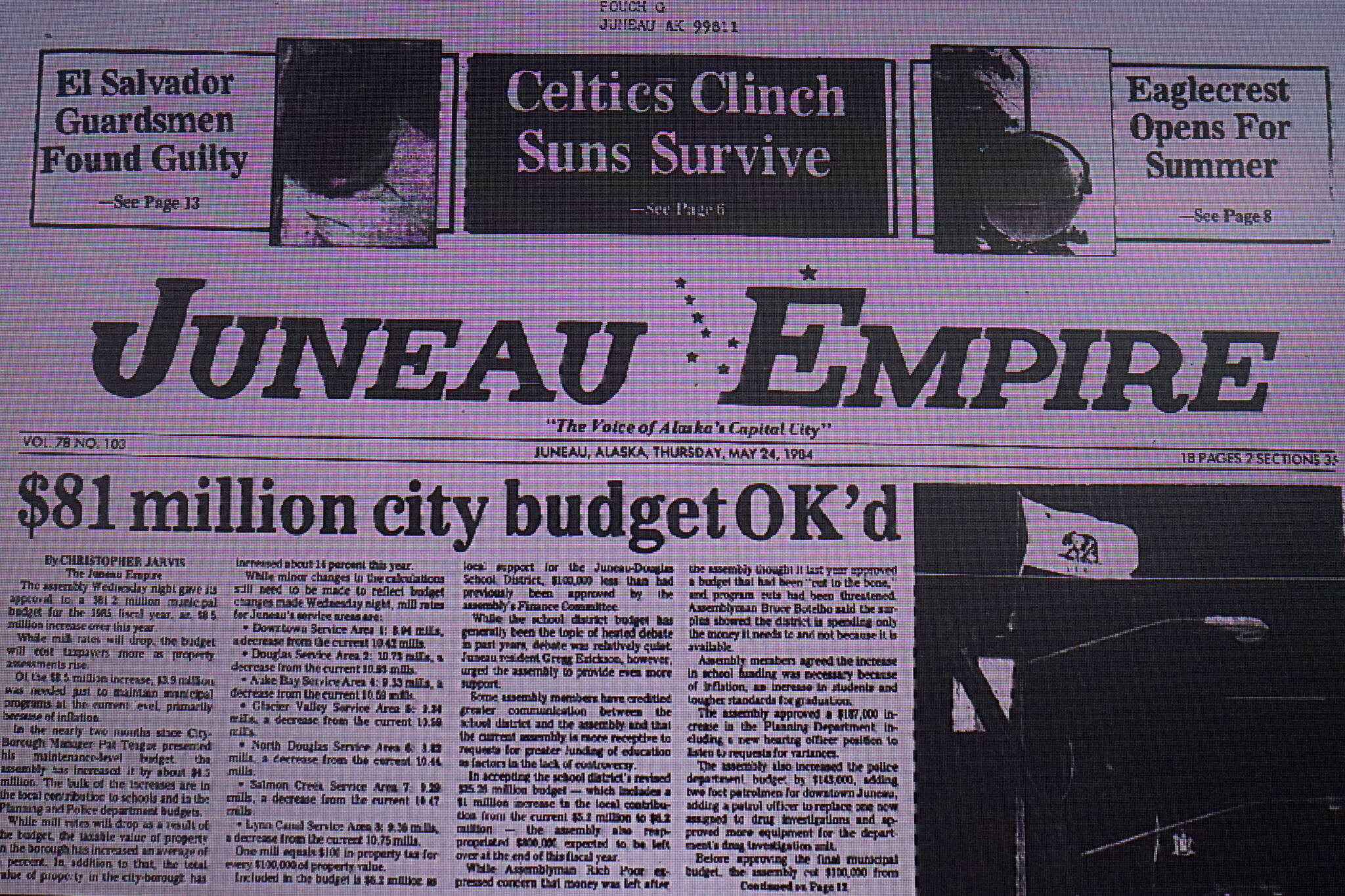Empire Archives is a series printed every Saturday featuring a short compilation of headline stories in the Juneau Empire from archived editions in 1984, 1994 and 2004.
This week in 1984, the Assembly gave its approval to an $81.2 million municipal budget for the 1985 fiscal year, an $.8 million increase over this year. While mill rates will drop, the budget will cost taxpayers more as property assessments rise, Of the $8.5 million increase, $3.9 million was needed just to maintain municipal programs at the current level, primarily because of inflation, In the nearly two months since City-Borough Manager Pat Teague presented his maintenance-level budget the Assembly has increased it by about $4.5 million. The bulk of the increases are in the local contribution to schools, and in the planning and police department budgets. The taxable value of property in the borough has increased an average of 6%. In addition to that, the total value of property in the city-borough has increased about 14% this year. Mill rates for various parts of Juneau are set for between 8.82 mills in the North Douglas service area to 10.73 mills in the Douglas service area.
Today the Assembly is considering a municipal budget of about $140 million (and $460 million in total expenditures when all CBJ entities such as the Juneau School District and Bartlett Regional Hospital are factored in). Assembly members on Wednesday night tentatively set the mill rate for the coming fiscal year at 10.04, down from the current rate of 10.16 and the initially proposed rate of 10.32 mills.
Original Story: “$81 million city budget OK’d,’ by Christopher Jarvis. 5/24/1984.
This week in 1994, the look of Juneau’s city government is white, male and getting more so. A recent report by the Juneau Women’s Council shows that 32% of people on city-borough boards and commissions are women; 74 of the 234 members in 1993. Barb Belknap, chairwoman of the council, said that number is down from a 1991 high of 34%. “Despite several years of effort to make Juneau’s municipal Assembly more aware of the tremendous preponderance of men as opposed to women on city boards and commissions, this year it’s worse,” she said. “We really feel that there is such a disparity there something should be done.” This year, for the first time in a decade, the city-borough Assembly is all white males, ranging in age from 34 to 53. Part of the reason is a lack of women candidates willing to run for office. Assembly member Al Clough, chair of the Assembly committee charged with finding board and commission members, said last week that if gender representation is out of balance in the city “it’s not our fault.” At the time of the gender equity report, there were 15 vacancies on the 29 city boards and commissions.
Today there remain numerous vacancies on city boards and commissions. Six of the nine assembly members are women.
Original Story: “Four years later no change: City government is still predominately white, male,” by Susan S. Christianson. 5/23/1994.
This week in 2004, on May 25 voters will decide once again whether they want to build a high school at Dimond Park. Voters face a ballot measure, placed there by a citizens’ initiative, that asks them whether they want the city to refrain from using any of the bonds approved in 1999 to build a new school. A “yes” vote says in effect: Don’t build the Dimond Park high school. A “no” vote says: Build the school now. That’s the simple version. The ballot measure actually conditions building the Dimond Park school on having an enrollment of at least 2,100, on having identified funds for an annual operating budget of nearly $1.7 million, and on being the size mentioned in the voters’ information pamphlet for the 1999 bond election. The initiative sponsors have said they want to hold the school district to its enrollment projections from 1999 for 2004. But supporters of the Dimond Park school say Juneau-Douglas High School is overcrowded now, with 1,575 students, and a new school is needed. The school district can’t possibly gain several hundred high school students between now and Dec. 31, when the state’s opportunity for reimbursement expires. That’s why the May 25 bond measure, if it passes, effectively kills the currently designed school at Dimond Park.
Today what became Thunder Mountain High School will hold its final graduation this weekend before students are consolidated into Juneau-Douglas High School: Yadaa.at Kalé starting next fall. Next week’s Empire Archives will feature the results of the May 25, 2004, election and how the outcome affected the school’s fate.
Original Story: “New Valley high school: What’s a voter to do?” by Eric Fry. 5/21/2004.
• Contact Mark Sabbatini at mark.sabbatini@juneauempire.com or (907) 957-2306.

